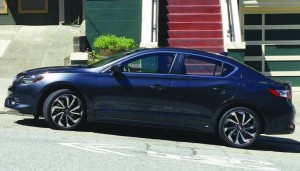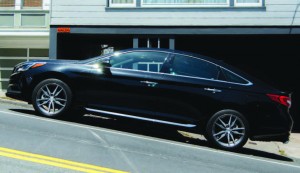 Upscale can mean many things. For some, it translates to straight-ahead luxury, like a shopping spree through Union Square’s prestige names. For others, it means having a car that’s sportier and more responsive, as if it’s been to the gym every day while watching its carbs.
Upscale can mean many things. For some, it translates to straight-ahead luxury, like a shopping spree through Union Square’s prestige names. For others, it means having a car that’s sportier and more responsive, as if it’s been to the gym every day while watching its carbs.
The two sedans tested here–the Acura ILX and the Hyundai Sonata Sport 2.0T–don’t have identities that inspire envy, but they do deliver on the sportier side of things.
Both Acura and Hyundai are in a pitched fight to raise their brand equity. As cars and their features become more similar, carmakers must imbue their offerings with their brand characters. The allure of a status symbol with a definable personality can be a strong motivator to get a buyer to a dealer.
If you don’t have that allure, then it can be very much like being in the closet, where you’re not being seen, no matter how good you are. And so it is with Acura and Hyundai and many others, as these companies work to produce offerings that make a mark when they’re driven and raise the allure.
 In pricing, both the ILX and the Sonata Sport 2.0T top out around $35K, the difference being size: the Acura is based on the compact Honda Civic, while the Sonata is a mid-sized sedan. Size aside, these two sport sedans have very similar personalities. They have nice firm suspensions, smooth power, and dialed-in driving positions; they both feel engaged. They also have enough exhaust burble to make them sound kicky as you cruise the Castro (the Sonata Sport, in
In pricing, both the ILX and the Sonata Sport 2.0T top out around $35K, the difference being size: the Acura is based on the compact Honda Civic, while the Sonata is a mid-sized sedan. Size aside, these two sport sedans have very similar personalities. They have nice firm suspensions, smooth power, and dialed-in driving positions; they both feel engaged. They also have enough exhaust burble to make them sound kicky as you cruise the Castro (the Sonata Sport, in
particular).
Acura has Honda’s revvy i-VTEC valvetrain to bang out 201 horses from its 2.4-liter, four-cylinder engine. The Sonata Sport adds a turbo to its 2.0-liter engine to produce 245 horses. As a result, the Sonata has more surge. There is such little turbo lag—the time it takes for the turbo’s impeller to spin up and accelerate the exhaust gases—that this Sport feels like it’s always ready to go.
 The ILX feels ready too, and its eight-speed automatic, with two more speeds than the Sonata’s, is very responsive. But the terrible shame of the ILX’s revisions for 2016 is the elimination of the sweet-shifting manual transmission. The Sonata Sport doesn’t offer a manual, either.
The ILX feels ready too, and its eight-speed automatic, with two more speeds than the Sonata’s, is very responsive. But the terrible shame of the ILX’s revisions for 2016 is the elimination of the sweet-shifting manual transmission. The Sonata Sport doesn’t offer a manual, either.
Inside, the aforementioned driving positions get you ready for serious driving with lower cushions that power up in front for thigh support that gives a real buckety feel. The dashboards diverge: the Acura presents you with a spacey, two-screen setup, while the Hyundai’s one-screen panel is flatter and more straightforward, which befits its more mainstream mission.
Both succeed with appeal. Acura and Hyundai are not forgiven for offering these sporty models without manual transmissions, but both the ILX and the Sonata Sport 2.0T are memorable drives, and they have distinguishing allures.
Now it’s up to their makers to get these cars out of their closets.
Philip Ruth is a Castro-based automotive photojournalist and consultant at www.gaycarguy.com. Check out his automotive staging service at www.carstaging.com
Recent Comments